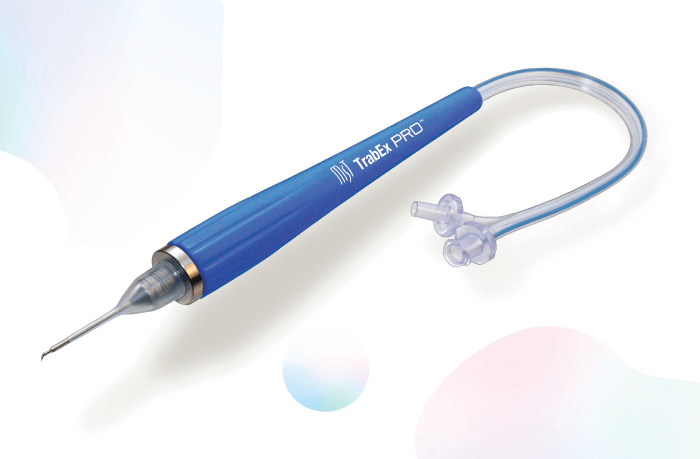
It is estimated that 76 million patients across the globe have suffered from glaucoma in 2020; the number is expected to grow to 111 million by 2040 (1). Finding simple, versatile, yet effective glaucoma solutions is increasingly important. MIGS has been a fantastic innovation, giving cataract surgeons new tools with which to treat glaucoma – ultimately providing a way to treat the disease sooner and with a high safety profile. Nevertheless, some MIGS technologies, such as stenting and scaffolding, can present challenges in terms of surgical technique and reimbursement. And that’s where MST’s irrigating goniectomy with TrabEx Pro comes in.
Irrigating goniectomy is a new MIGS procedure that continues on from the legacy of goniotomy – a well-established procedure first described by Barkan in 1938 (2). Irrigating goniectomy, first introduced by the MST Trabectome in 2004, works by incising and opening trabecular meshwork (TM) tissue with the support of active IA, exposing Schlemm’s canal and allowing aqueous to drain via several collector channels and the intrascleral venus plexus. Irrigating goniectomy is well supported with clinical literature. A recent meta-analysis states it “can be expected to lower the IOP by approximately 36 percent to a final average IOP around 16 mmHg while decreasing the number of medications by less than one. After 2 years, the overall average success rate is 66 percent. The rate of visually threatening complications is <1 percent.” (3)
Traditional goniotomies create a single incision in the TM with a cystotome or keratome. Though effective in pediatric patients, they have a limited effect in adults because the lack of elasticity in adult TM can allow remaining tissue to reocclude the outflow system (4).
Irrigating goniectomy using the Trabectome removes a central strip of the TM with electrosurgical ablation with the aim of preventing reocclusion from remaining leaflets of tissue. TrabEx Pro works in a similar fashion but excises TM tissue with a trapezoidal bladehead that features serrated blades – tailored to varying patient anatomies. The result? Cleanly-cut removal of the TM: the “goni-ectomy”.
Perhaps the greatest innovation of the MST Glaucoma portfolio is the incorporation of IA. The addition of irrigation pressurizes the anterior chamber to help prevent intraoperative blood reflux in the angle and provide maximum visibility during surgery, while aspiration assists in pulling the TM against the serrated blades and facilitating a precise and complete excision of tissue. The TrabEx Pro features the latest in irrigating goniectomy technology, a silicone infusion sleeve that maximizes the surgical benefit of IA and allows for use in varying incision sizes.
The instrument is indicated for both adult and pediatric patients and can be used in combination with cataract surgery or as a standalone procedure to treat open angle, narrow angle, pseudoexfoliative, pigmentary, mild, moderate, and severe glaucoma.
TrabEx Pro is best used in a 2.2-2.5 mm incision. And because it can connect to any phaco platform to incorporate fluidics for IA, it does not require any capital equipment investment. Moreover, it is backed by strong reimbursement, which allows the technology to be widely offered.
TrabEx Pro will be available in the US, Canada, and Europe in January 2021.
References
- YC Tham et al., “Global prevalence of glaucoma and projections of glaucoma burden through 2040: a systematic review and meta-analysis,” Ophthalmology, 121, 2081 (2014). PMID: 24974815.
- O Barkan, “Technic of goniotomy,” Arch Ophthalmol, 19, 217 (1938). DOI: 10.1001/archopht.1938.00850140059006.
- K Kaplowitz et al., “Review and meta-analysis of ab-interno trabeculectomy outcomes,” Br J Ophthalmol, 100, 594 (2016). PMID: 26733487.
- J Liu et al., “Ab interno trabeculotomy: Trabectome[trademark] surgical treatment for open-angle glaucoma,” Expert Review of Ophthalmol, 4, 2, 119 (2009).
